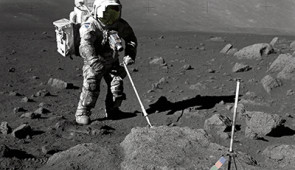The Moon is 40 million years older than previously thought
Northwestern scientists help analyze lunar samples, collected by Apollo 17 astronauts
- Link to: Northwestern Now Story
- New study analyzes tiny crystals inside lunar dust collected in 1972 by the last manned mission to the Moon
- By estimating the crystals’ age, researchers report the oldest lunar date yet
- Researchers used Northwestern’s atom-probe tomography tools to perform radiometric dating
EVANSTON, Ill. — By analyzing tiny lunar crystals gathered by Apollo 17 astronauts in 1972, researchers recalculated the age of the Earth’s Moon. Although previous assessments estimated the Moon as 4.425 billion years old, the new study discovered it is actually 4.46 billion years old — 40 million years older than previously thought.
Led by researchers at the Field Museum and the University of Glasgow, the study was made possible by Northwestern University’s atom-probe tomography facility, which “nailed down” the age of the oldest crystal in the sample. By revealing the age of these telltale zircon crystals — found hidden within dust collected from the Moon — researchers were able to piece together the timeline of the Moon’s formation.
The study was published today (Oct. 23) in the journal Geochemical Perspectives Letters.
“This study is a testament to immense technological progress we have made since 1972 when the last manned Moon mission returned to Earth,” said Northwestern’s Dieter Isheim, who co-authored the study. “These samples were brought to Earth half-a-century ago, but only today do we have the necessary tools to perform microanalysis at the requisite level, including atom-probe tomography.”
The atom-by-atom analysis enabled researchers to count how many atoms in the zircon crystals have undergone radioactive decay. When an atom undergoes decay, it sheds protons and neutrons to transform into different elements. Uranium, for example, decays into lead. Because scientists have established how long it takes for this process to unfold, they can assess the age of a sample by looking at the proportion of uranium and lead atoms.
“Radiometric dating works a little bit like an hourglass,” said the Field Museum’s Philipp Heck, the study’s senior author. “In an hourglass, sand flows from one glass bulb to another, with the passage of time indicated by the accumulation of sand in the lower bulb. Radiometric dating works similarly by counting the number of parent atoms and the number of daughter atoms they have transformed to. The passage of time can then be calculated because the transformation rate is known.”
Isheim is a research associate professor of materials science and engineering at Northwestern’s McCormick School of Engineering and manager of Northwestern’s Center for Atom-Probe Tomography (NUCAPT). David Seidman, the Walter P. Murphy Professor Emeritus of Materials Science and Engineering at McCormick and founding director of NUCAPT, also co-authored the study. Heck is the Field Museum’s Robert A. Pritzker Curator for Meteorites and Polar Studies, senior director of the Negaunee Interactive Research Center and professor at the University of Chicago. Jennika Greer, a research associate professor at the University of Glasgow, is the study’s lead author. When the research began, she was a Ph.D. candidate in Heck’s laboratory.
More than 4 billion years ago, when the solar system was still young and the Earth was still growing, a giant Mars-sized object crashed into the Earth. A colossal hunk broke off Earth to form the Moon, and the energy of the impact melted the rock that eventually became the Moon’s surface.
“When the surface was molten like that, zircon crystals couldn’t form and survive,” Heck said. “So, any crystals on the Moon’s surface must have formed after this lunar magma ocean cooled. Otherwise, they would have been melted and their chemical signatures would be erased.”
Because the crystals must have formed after the magma ocean cooled, determining the age of the zircon crystals would reveal the minimum possible age of the Moon. But, to pinpoint the maximum possible age of the Moon, researchers turned to Northwestern’s atom-probe tomography instruments.
“In atom-probe tomography, we start by sharpening a piece of the lunar sample into a very sharp tip, using a focused ion beam microscope, almost like a very fancy pencil sharpener,” Greer said. “Then, we use UV lasers to evaporate atoms from the surface of that tip. The atoms travel through a mass spectrometer, and how fast they move tells us how heavy they are, which in turn tells us what they're made of.”
After determining the materials in the sample and performing radiometric dating, the researchers concluded that the oldest crystals are about 4.46 billion years old. That means the Moon must be at least that old.
It’s important to know when the Moon formed, Heck said, because “the Moon is an important partner in our planetary system. It stabilizes the Earth’s rotational axis. It’s the reason there are 24 hours in a day. It’s the reason we have tides. Without the Moon, life on Earth would look different. It’s a part of our natural system that we want to better understand, and our study provides a tiny puzzle piece in that whole picture.”
The study, “4.46 Ga zircons anchor chronology of lunar magma ocean,” was supported by NASA and the Field Museum’s Women’s Board Women in Science Graduate Fellowship. NUCAPT is supported by the National Science Foundation, the Office of Naval Research and the Paula M. Trienens Institute for Sustainability and Energy.
Multimedia Downloads
Study images



